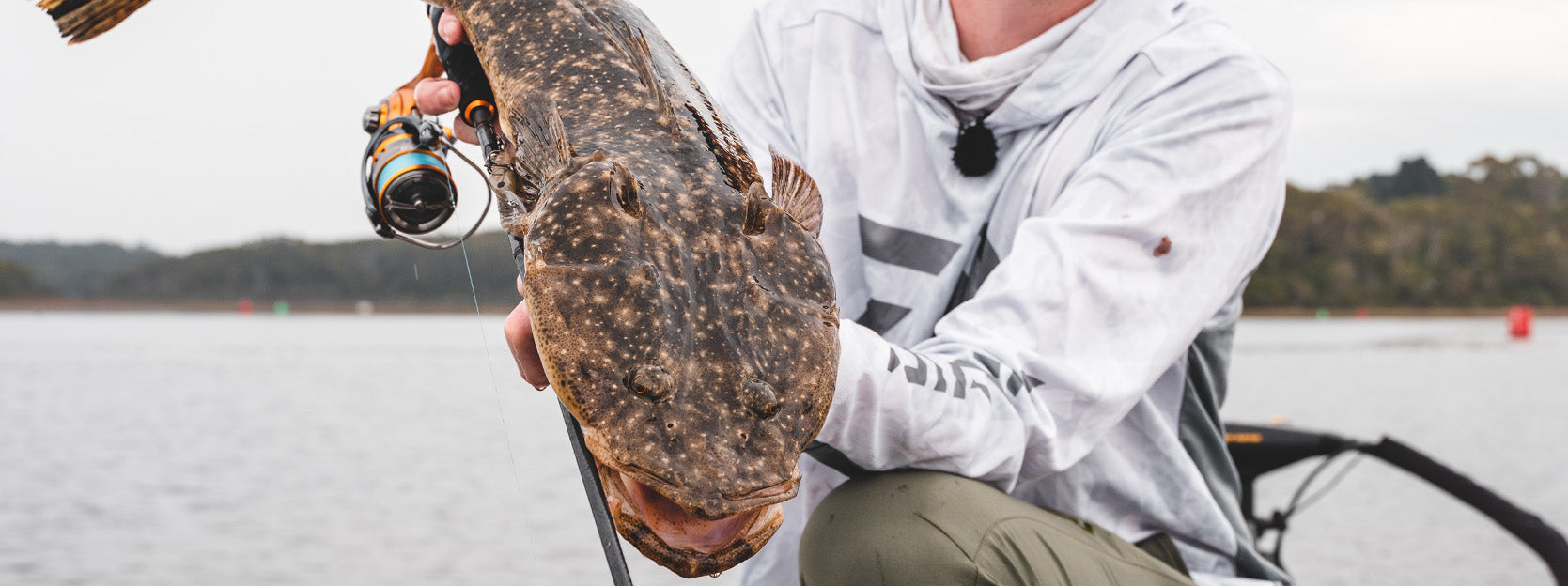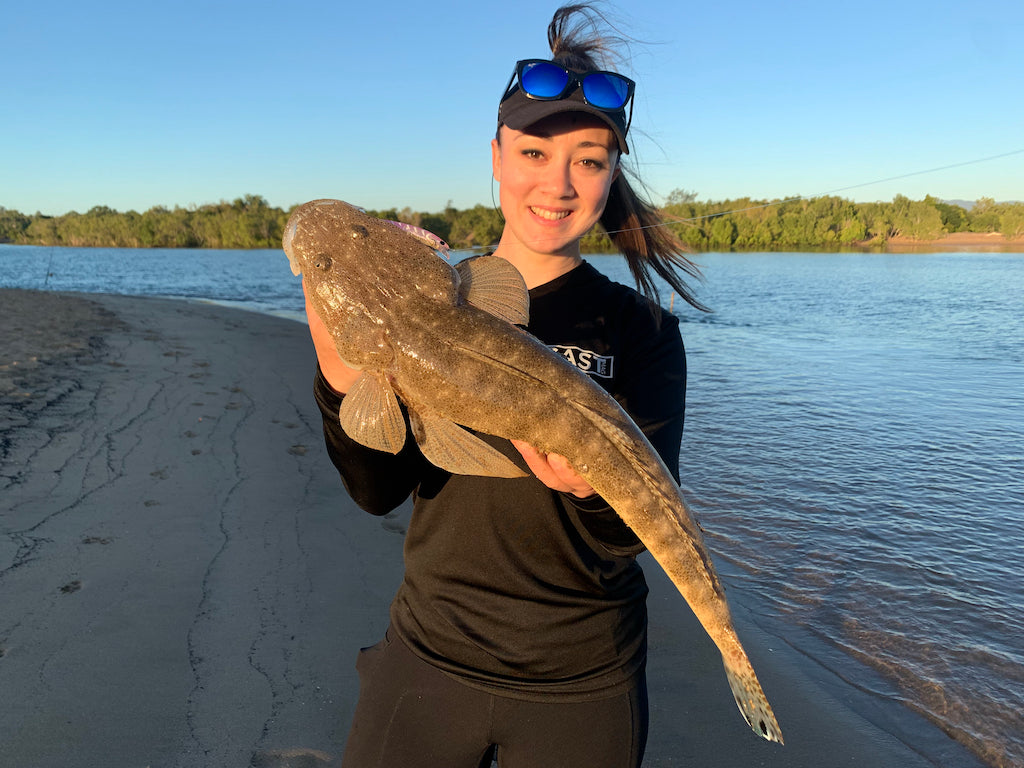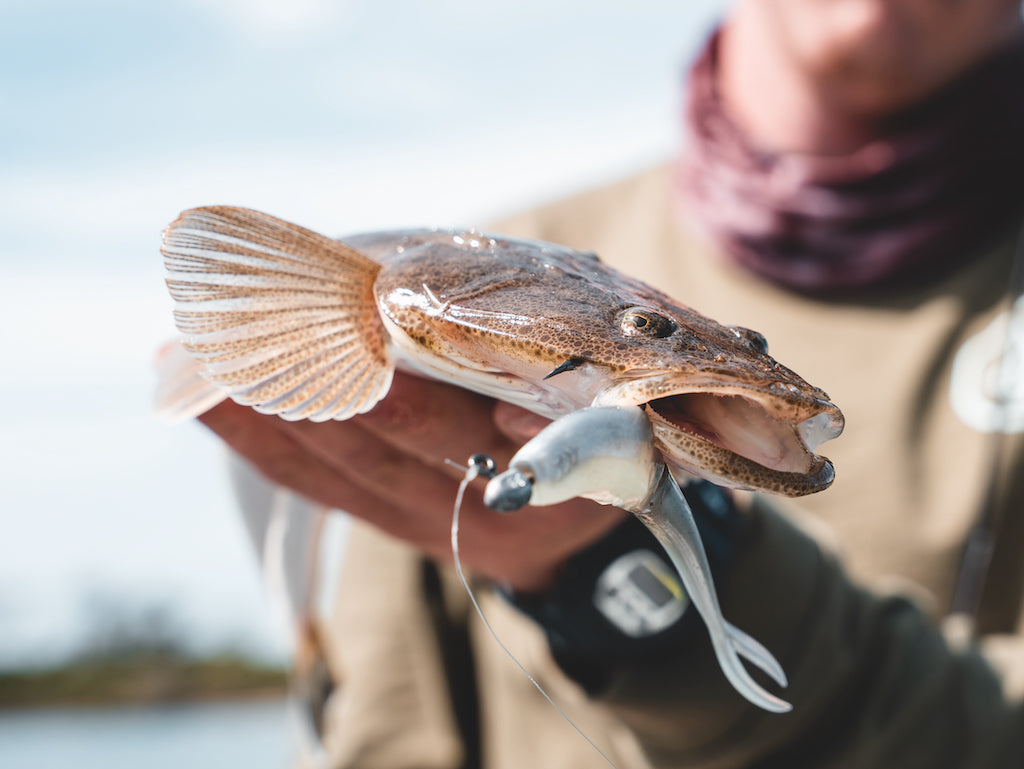Posted 31th August 2022
How to Catch Flathead: A Complete Guide


By Robert Thornton
Flathead are a species synonymous with Australian saltwater fishing, and given how widespread and common they are, it’s easy to see why so many anglers spend countless hours chasing them each year. Their willingness to smash both lures and bait, tendency to live in easily accessible estuaries and their top notch eating qualities are just some of the things that make them so popular. Anglers have targeted flatties on lures and bait for decades, and while a lot of the gear has changed, the basic methodology remains largely the same.
Daiwa’s range of light rod and reel setups, lures, terminal tackle and accessories offer a heap of options to anyone wanting to up their flathead game, or even tick off that first one.
 Flathead Knowledge
Flathead Knowledge
When anglers talk about flathead, they are generally referring to the dusky flathead (Platycephalus fuscus, which literally means ‘flat head dusky’). Their range extends along the East coast from about the Gippsland Lakes region in Victoria to Cairns in Far North Queensland. They are the largest flathead species, and by far the most well known.
Other similar species such as sand flathead, bar-tail flathead, blue-spot flathead and fringe-eye flathead can be found around various parts of Australia as well, and will often live in similar areas and respond to the same techniques.
Their flattened body shape lends itself to feeding in shallow water, and their large mouth, forward-pointing eyes and short but sharp bursts of speed make it possible for them to hunt down large, fast-moving prey, despite their reputation as a placid bottom feeder. Most flathead species sport a sandy or muddy hue, which is often mottled, allowing them to blend in with their environment while they lay in ambush. It’s for this reason that good flathead anglers will keep their lure or bait moving, with the aim being to bring it past a waiting flathead. Flatties will get up and chase prey, but they generally won’t move very far.
Breeding occurs at different times throughout their range, with more northern strains opting for the cooler months, mid latitudes for spring, and flathead in southern waters preferring summer. During these times they will school up, with a dozen or so smaller males gathering around a single female, which are sometimes in excess of a metre long. Anglers fishing during the spawning period know that if a smaller male is landed, it’s a good idea to keep fishing that area, as a larger female will likely be close by.
It goes without saying that larger females should be returned to the water, as these specimens are responsible for supplying the next generation of flathead. Fisheries in Victoria have also recently started stocking flathead fingerlings (and other estuarine species) into the Gippsland Lakes; an area where their stocks have suffered over the past few decades. Strict slot and bag limits have also seen their numbers bounce back throughout their range, and all signs are looking good for this iconic sport fish in the future.
 Flathead Fishing
Flathead Fishing
Flathead are highly susceptible to a range of fishing techniques, and this is one of the main reasons they are so widely appreciated in Australia. Any angler, whether they’re a fresh-faced bait soaker new to the sport, or even a jaded obsessionist who’s tried every luring technique under the sun, should be able to find a way to chase flathead that’s not only effective, but also highly entertaining and rewarding. Personally, I really like walking along shallow sand flats and fly fishing for them. I believe that flathead are one of those rare species that actually respond better to artificials than bait, but that’s a discussion better had over a beer around a campfire or at a boat ramp.
There are three main ways that people target flathead: casting lures, trolling lures, and fishing with bait. Of course, within these techniques, there are heaps and heaps of different applications, and realistically, the amount of ways you can catch flatties with a rod and reel is limitless. Here we will outline the basics, and then your imagination can take over from there!
How to Catch Flathead on Bait
I will reiterate that there are many ways to catch flathead, and that my way might not necessarily be theway. My aim is to provide information to help newcomers nail their first flatty.
There is no shame in bait fishing for flathead, or any species for that matter! Bait rigging and fishing takes a level of skill, and I have seen seasoned lure pros struggle when thrown back into an environment where they have to use bait.
The first thing to understand with flatties is that they are hunters, and they usually want something that is alive or moving. Live baits are preferred, however dead baits can work too, although the latter works far better when the angler animates the bait to keep it from sitting there and attracting scavengers.
Flathead will happily snaffle most things, with worms, yabbies, dead pilchards and live mullet just some regular favorites. Rigging doesn’t have to be complicated, and a standard running sinker rig with a swivel is fine for most bait fishing. A 15lb trace like J-Thread Nylon is a good starting point, especially given that flathead like to scoff baits and their teeth are notorious for wearing through light traces. Hooks around the 1/0 size are a good allrounder.
If you’re specifically chasing larger fish, live baits like legal whiting or bigger mullet fished unweighted on a circle hook in the 3/0-4/0 size range is a good ploy.
Just remember that bait fishing for flathead will work best if you find areas where flathead are sitting and waiting for prey to come to them. The mouths of small creeks, shallow drop-offs, drains, the edges of weed beds and other likely ambush points are all good spots to put your bait.
As I alluded to before, dead baits will work best if they are kept moving. You don’t necessarily need to cast and wind your dead bait like you would with a lure. Dead bait specialists will usually just gently drag their bait along the bottom, pausing it often, gradually working over a likely area. Doing this will allow you to quickly find out if there are hungry flathead around.
Flathead can attack with speed, but once they have their prey will usually settle back down onto the bottom to digest it. If you suddenly feel dead weight, there’s a good chance a flatty has eaten your bait. A gentle lift of the rod, or a slow take-up of slack if using a circle hook, is all that’s needed to pull tight to your prize.
 How to Troll for Flathead
How to Troll for Flathead
Once again, there is no one way to employ this technique. I’ve heard of some whacky tricks people use when trolling for flatties, such as trolling a 200mm lure only 3m behind the boat in the prop wash, or having four lines out at a time in a staggered formation. If you’re new to this, it helps to start simple. Doing it simply has produced many fish for me!
People can get very political about trolling, but there’s only one old trolling adage I try to remember: ‘you’re driving the lure, not the boat’. What this means is, you need to think about the boat’s speed and trajectory as you troll.
I find a speed between 2-3km/h is good, which is a slow to medium walking pace. They will chase down lures moving faster, but your lures aren’t tuned to be fished that quick!
On the topic of trajectory, you need to remember that your lures’ behavior will change as the boat winds its way along a bank or through a channel. Between 15-20m is a comfortable distance to have your lures at. If your string is too short your lures might not find the bottom, but if they’re too far back you’ll regularly lose contact with them.
Trolling is generally done in water ranging from about 3ft-10ft, meaning small hardbodies are perfect for this technique. It’s important to fish with lures that will hit the bottom occasionally, as this will kick up sand and mud, and in turn attract that flathead you’re chasing.
Daiwa’s range of smaller hardbodies are excellent for flathead trolling, with the Infeet Kodachi, Infeet Spike 44EXDR and Steez Shad 60SP DR all proven flathead catchers. Having a range of bright colours such as greens, pinks and oranges along with more natural shades resembling crabs, shrimps and small baitfish will have you well equipped for a bit of flathead trolling.
Using a hardbody that dives to roughly the depth you’re fishing is a good way to ensure the lure doesn’t get ‘bogged down’ or fouled up with mud. You want your lures to hitting the bottom every few seconds, and not completely plowing through it.
In finding an area to troll, you want a ‘run’ that allows at least a hundred meters (and preferably more) of trouble free trolling. This could be along a sandy bank, through a channel, or over the top of a shallow flat at high tide.
This technique works well when the fish are scattered, which tends to happen outside of their spawning periods.
 How to Catch Fathead Casting Lures
How to Catch Fathead Casting Lures
Casting lures for flathead, simply put, is just good fun! It can be as involved or as laid back as you like, plus it’s the perfect middle ground between being challenging enough that it doesn’t get boring, but not too complicated that scares novices off.
Anglers don’t need fancy gear to fish this way, plus most Australians living in coastal areas likely live within walking distance of an area where they can do it.
For a land-based angler, a light spin set-up, a handful of lures and a sense of appreciation for the outdoors is all you need.
If you’re after ideas, a TD Hyper spin rod (model 662MLFS) and Exceller LT reel (2000D or 2500D is a perfect flatty casting combo that’s affordable, versatile and will last you many sessions. Mainlines between 6-10lb and leaders in the 8-15lb range are fine.
Daiwa’s range of lures and soft plastics are also fantastic for a bit of flathead hunting. For hard baits, you can’t really go past the Double Clutch 60SP-G and 75SP-G models, especially in shallower water. For ultra shallow work, when you’re casting onto those sun-warmed flats in shin-deep water, the Presso Minnow in 60F and 95SP models will really shine, and perfectly imitate the small whiting, mullet and garfish trying to avoid hungry mouths.
In the deeper channels, the Steez Metal Vibeis perfect for bouncing along the bottom and drawing in fish from afar.
Onto plastics, which are arguably the most effective lure for flathead anywhere, Daiwa’s Bait Junkie range have got absolutely everything covered. For beginners, the 2.5 Inch Minnow and 2.5 Inch Grub are two must-haves. Rigged on jigheads between 1/12oz and 1/4oz (depending on the depth and current) they are like jelly beans to flathead. Fished with short sharp hops along the bottom, with plenty of time sitting on the bottom between, they willattract flathead. Bait Junkies are made from a buoyant plastic material, meaning the tail will wave around tantalisingly in the current even when the lure isn’t being worked.
Finding areas to cast lures at flathead is never too difficult. Shallow flats are worth working your lures over, as are the slightly deeper areas they drop off into. Casting your lures into the same areas you would put your baits is a good idea too, and anywhere you can see bait in the form of small fish, shrimps or yabby holes is always worth inspecting.
Sand and mud are the preferred terrain for flathead, but areas with weed, rock or rubble mixed in are great too, because they provide habitat for the prey, as well as cover for the prowling flathead.
In general, if it looks good, it’s worth a cast. When you start getting responses from the fish, you can slow down, take note of the area, and then fish it more thoroughly and hopefully uncover more fish.
Feeling Flat?
If you’re looking to improve your flathead game or just get that first one on the board, it doesn’t really matter how you do it! After that, every fish you land will help you piece together the puzzle and contribute to your understanding of this great sportfish. Once you’ve got it downpat, you’ll be able to enjoy convenient food gathering or relaxation jaunts down to the local estuary. Everytime I go flathead fishing, the thought of a metre long unicorn is ever-present in the back of my mind, and I know that the next cast could see me connected with one of these fabled beasts.
If you’re after something new and challenging, flathead fishing really has it all!
















